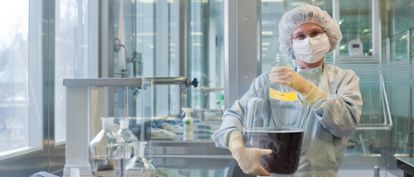How anthroposophic medicine works

What exactly is anthroposophic medicine?

Anthroposophic medicine is an integrative medicine that focuses on the holistic needs of the patient. It relates to two schools of medicine: on the one hand, scientific, conventional medicine with its methods and results, and on the other hand, the spiritual scientific knowledge of anthroposophy. The two approaches go hand in hand. After all, humans not only consist of a body, but also a soul and an individual personality. Healing, as we see it, is not only about fighting symptoms, but also about supporting your individual, holistic path to becoming healthy. Our medicines are designed to strengthen your organism’s ability to heal itself.
Sustainable and ecological

Anthroposophic medicine seeks to help both people and planet. We treat nature with respect with ecological principles at the heart of our pharmaceutical processes. Our responsibility starts with the raw materials and continues with the patients. We take this responsibility even further by paying attention to the biodegradability of our products and how residual materials can be disposed of properly. Our medicines are manufactured with active ingredients from nature in ways that are environmentally friendly, resource-saving and in respectful cooperation with our partners.
You are part of nature

Nature has powerful powers of healing. You can find this strength not only in medicinal plants, but also inside yourself. This is where Weleda medicines come in. They are designed not only to eliminate symptoms using active natural ingredients, but also to remind your body of its own natural powers of self-healing and to activate them. The quality and effectiveness of Weleda medicines are not only the result of our natural raw ingredients and special formulations, but also our production methods, some of which are unique processes used exclusively by Weleda.
Medicinal plants – freshly picked and processed
From seed to plant, to harvesting and processing, to the pharmaceutical process: each of the many individual steps serves to transform the power of this plant into a remedy.
Unique production methods
We have developed unique production methods in order to harness the powers of nature.

Metal mirror
The production of metal mirrors is a unique process which is both time-consuming and labour-intensive. To produce a gold mirror, for example, a small amount of this precious metal is liquefied and vaporised by steadily increasing the heat in a vacuum. The resulting metal mirror is deposited on the walls of a glass flask. It is then scraped off and processed in further steps to different medicines.

Potentisation process
We have developed our own potentisation process, which is based on the classical method according to Hahnemann. It takes place in special rooms that allow for quiet, undisturbed pharmaceutical work. Dilutions are rhythmically shaken by hand by our specially trained experts in order to produce different potencies. Every potency comes into being through the activity of a human being. Potentising work requires skill, concentration, inner calm and experience. In contrast to many classical homeopathic remedies, Weleda medicines are generally potentised over only a few stages and therefore contain analytically detectable concentrations of active ingredients.

Vegetabilised metals
Another special pharmaceutical process used by Weleda is the vegetabilisation of metals. In this process, a highly diluted, soluble preparation is produced from a naturally occurring metal, such as solid silver. This serves as a kind of fertiliser for the soil in which a medicinal plant can be grown. It allows the plant to absorb the metal through its roots, thereby potentising and dynamising the metal. At flowering time, the plant is harvested and composted. In spring of the following year, this compost is used to fertilise a new bed for the same plant species. This potentisation process is repeated once more and then the third-generation plant is processed into a medicinal product. Not only does it contain the beneficial effects of the plant, but also, for example, the properties of the dynamised silver, which has been activated over the course of three years as part of the plant’s life process.

Rh procedure
The abbreviation Rh, which appears in the name of some Weleda medicines, stands for “rhythm”. This pharmaceutical Rh process – practised only by Weleda – is used to produce special aqueous (so non-alcoholic) preparations from fresh plants. In the morning, juice pressed from the plants is repeatedly heated to 37 °C and rhythmically mixed. Then in the evening it is cooled to 4 °C and rhythmically mixed again. The amount of light to which the preparation is exposed also changes according to a certain rhythm. The resulting fermented preparations do not require additional preservatives. The Rh process used by Weleda is currently being integrated into the European Pharmacopoeia (Ph. Eur.).



